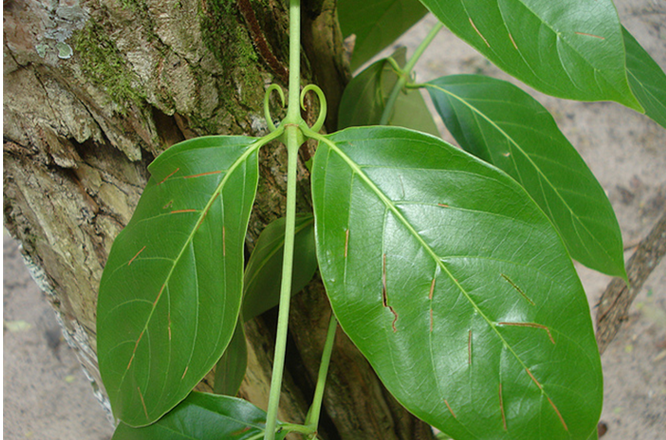
Cat’s Claw & Parrot’s Beak (Uncaria spp.)–Rainforest Panacea
By Ellen Kamhi, PhD, RN, AHG, AHN-BC
Cat’s Claw is a a powerful immune stimulater and aids digestion…
It is a broad spectrum antimicrobial that can eliminate fungi, bacteria, viruses and parasites. The highlands of the Amazon rainforest in Peru is the home of the Ashanica Indians. There, the indigenous healers have used Cat’s Claw (Uncaria tomentosa), which they call Una de Gato, for thousands of years, as an herbal medicine for many ailments, especially those which involve the digestive tract and the immune system.
The plant is named for the large hook-like thorns that come off the ends of a long vine which locals have stated resembles the Jaguar’s claw. The medicinal part is the root and the inner bark of the stem. In order to preserve the plant, the inner bark is usually used, while the roots are spared, to allow the next harvest to continue to grow.
In Africa, according to leading ethnobotantist Anthony Kweku Andoh, Ph.D., F.L.S. a parallel species, Uncaria africana, (the parrot’s beak), is used by the Ashanti clan people for similar medicinal purposes. In his fascinating book, The Parrot’s Beak & the Cat’s Claw: Hope for True Healing from the Rain Forests of Africa and South America, Dr. Andoh points out the similarity and what is believed to be the common origin of the Ashanica Indians of South American and the Ashanti people of Western Africa. These cultures are somehow linked by a common ancestral people known as the Olmecs, a pre-Mayan civilization which have also been identified as the predecessors of the Ashanti people in Africa. The Olmecs provide an anthropological link between Africa and South America. Indeed, according to Dr. Andoh, the similarity between the folkloric, cultural, ethnobotanical and ethnolinguistic relationship between these two peoples is uncanny, despite the fact that the Atlantic divides the two cultures by 3,000 miles!
There are several different species of Cat’s Claw. Some are medicinal, while others are quite poisonous. Be sure to use a commercially prepared Cat’s Claw from a reputable herbal manufacturer!
Modern research has shown that the species known as cat’s claw (Uncaria tomentosa) contains the highly active ingredient isopteropodine, which has the most pronounced effect of activating immune system function. A formidable array of scientific studies has been performed on Uncaria. In 1985, the journal Planta Medica reported on the alkaloids of Uncaria tomentosa and their ability to increase phagocytosis. Phagocytosis is the action of the white blood cells as they engulf and destroy invading organisms, such as bacteria and viruses. Additional compounds may help to explain the herb’s antioxidant properties, its ability to protect cells from damage caused by free radicals and the anti-viral, and anti inflammatory properties also attributed to this herb. Some companies that sell Cat’s Claw in the health food industry, claim that only TOA Cat’s Claw should be used. However, this assertion is debatable. Cats claw naturally contains a large array of components, including small amounts of Tetra- oxindole alkaloids, or TOA , and pentacyclic oxindole alkaloids or POA. Although isolated TOA may be toxic in high amounts, scientific analysis shows that TOA helps support immune function. Cat’s Claw has traditionally been used with the TOA intact, with no report of adverse effects.
Health food stores carry Cat’s Claw as a tea, tincture, extract and capsule. Due to Cat’s Claw’s adaptogenic properties, it can be taken regularly as a tonic and also can be used in higher doses for an acute or chronic illness. In general , use 100 mg/day in divided doses, or 30 drops 3 times per day. Cat’s Claw can also be used externally as a poultice for wounds and skin irritations. Use a well identified Cat’s Claw, Uncaria tomentosa. There are few reports of side effects except for occasional mild gastrointestinal disturbances.
Ellen Kamhi PhD RN, The Natural Nurse®, can be heard on radio daily. She is the author of several books, including Arthritis, The Alternative Medicine Guide. Dr. Kamhi has been involved in natural health care for over 4 decades. She also teaches certification courses in Herbal Medicine in person and online, and offers personal consultations. www.facebook.com/NaturalNurse (954) 418-2388

I am a nurse navigator for gyn/onc patients who are very eager to hear what natural things they can do to help themselves. Would love to be on your mailing list.
Thanks,
Penny
Hi Penny- Thanks for your comment! You may wish to refer to my book, Cycles of Life, which has alot of information on Natural Therapies for the Stages of a Woman’s Life.
http://www.amazon.com/gp/product/0871319284?ie=UTF8&tag=natunurs-20&linkCode=as2&camp=1789&creative=9325&creativeASIN=0871319284
Be Well!
ELLEN KAMHI PhD, RN, AHG, AHN-BC
Awesome post.